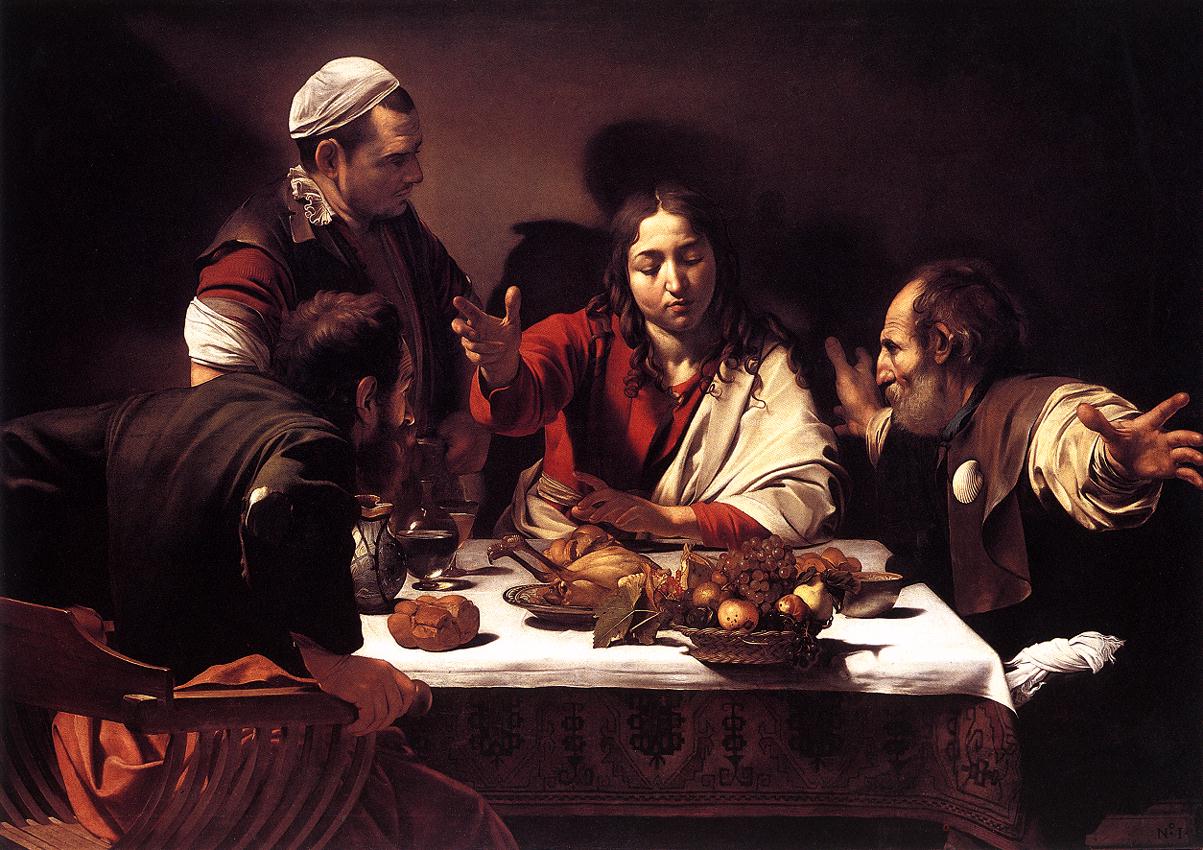 |
| Caravaggio, Supper at Emmaus (1601) |
This Sunday’s Gospel involves one of the Easter Sunday appearances of Jesus Christ to the Disciples. It starts out with the two disciples from the road to Emmaus returning to describe how “Jesus was made known to themin the breaking of bread,” an obvious Eucharistic reference. But in the midst of this discussion, Christ appears (Lk. 24:36-43):
While they were still speaking about this, He stood in their midst and said to them, “Peace be with you.” But they were startled and terrified and thought that they were seeing a ghost. Then He said to them, “Why are you troubled? And why do questions arise in your hearts? Look at my hands and my feet, that it is I myself. Touch me and see, because a ghost does not have flesh and bones as you can see I have.” And as he said this, He showed them His hands and His feet.
While they were still incredulous for joy and were amazed, He asked them, “Have you anything here to eat?” They gave him a piece of baked fish; He took it and ate it in front of them.
This passage is fascinating, because it tells us quite a bit about the nature of Christ’s Resurrected Body. Jesus is really clear that He’s not an immaterial ghost. He shows the Disciples His wounds, encourages them to touch Him, and physically eats in their presence (an event which would later be important in debunking the idea that the Disciples somehow collectively hallucinated Him). We see something similar a week later, as John 21:24-29 reports:
Caravaggio, The Incredulity of Saint Thomas (1602) Now Thomas, one of the twelve, called the Twin, was not with them when Jesus came. So the other disciples told him, “We have seen the Lord.” But he said to them, “Unless I see in his hands the print of the nails, and place my finger in the mark of the nails, and place my hand in his side, I will not believe.”
Eight days later, his disciples were again in the house, and Thomas was with them. The doors were shut, but Jesus came and stood among them, and said, “Peace be with you.” Then He said to Thomas, “Put your finger here, and see my hands; and put out your hand, and place it in my side; do not be faithless, but believing.” Thomas answered him, “My Lord and my God!” Jesus said to him, “Have you believed because you have seen me? Blessed are those who have not seen and yet believe.”
Here, He literally has St. Thomas put his hand in Jesus’ wounded side. His Body is clearly more than physical. He’s able to materialize in the locked room, and He disappeared from the sight of the two disciples at Emmaus in Luke 24:31. But while His spiritual Body is more than physical, it’s not less. That is, the glorification of His Body doesn’t involve His Material Body being destroyed, only made somehow greater than it had been.
Notice how beautiful the scenes above are, in which Christ has the Disciples see and touch His wounds. He doesn’t scold the Disciples (whose last encounter with Him, it should be recalled, involved all but one of them abandoning Him), but just shows them the physical signs of how much He loves them. That’s what a sacrament is, at heart: a physical manifestation of the love of God for us.
Christ’s glorified Body is the first fruits of what our own bodies will be like in the resurrection (1 Cor. 15:21-23, 42-50):
Luca Signorelli, Resurrection of the Flesh (1500) For as by a man came death, by a man has come also the resurrection of the dead. For as in Adam all die, so also in Christ shall all be made alive. But each in his own order: Christ the first fruits, then at his coming those who belong to Christ. […]
So is it with the resurrection of the dead. What is sown is perishable, what is raised is imperishable. It is sown in dishonor, it is raised in glory. It is sown in weakness, it is raised in power. It is sown a physical body, it is raised a spiritual body. If there is a physical body, there is also a spiritual body.Thus it is written, “The first man Adam became a living being”; the last Adam became a life-giving spirit. But it is not the spiritual which is first but the physical, and then the spiritual. The first man was from the earth, a man of dust; the second man is from heaven. As was the man of dust, so are those who are of the dust; and as is the man of heaven, so are those who are of heaven.Just as we have borne the image of the man of dust, we shall also bear the image of the man of heaven. I tell you this, brethren: flesh and blood cannot inherit the kingdom of God, nor does the perishable inherit the imperishable.
 |
| Noel Coypel, The Resurrection of Christ (1700) |
St. Paul’s use of “flesh” (both here and elsewhere) was used by the Gnostics to claim that while the spirit is good, matter is evil. This heresy is incredibly dangerous, because if flesh is inherently evil, then what to make of the Incarnation? We would have to say either that Christ was tainted by sin, or that He didn’t really take on our flesh. In either case, this would render the Atonement false.
Fortunately, that’s not the sense in which Paul means “flesh,” though. When Paul contrasts “spirit” and “flesh,” he’s really talking about where our mind and heart is: whether we’re seeking after the things of Heaven, or obsessed with earthly pleasures (Romans 8:5-9). So Paul doesn’t condemn our fleshly bodies, but does talk about how they need to be enhanced, spiritually. He makes this clearest in Romans 8:23, in speaking of the resurrection as the awaited “redemption of our bodies.” Our bodies aren’t evil things to be discarded, but weak things to be upgraded.
And in fact, read carefully, that’s the same thing he’s saying here. He’s not suggesting we throw our old bodies away, but that our bodies, “sown” in the grave, are raised in the resurrection in a glorified form, not unlike the metamorphosis that as a caterpillar undergoes in becoming a butterfly. So the resurrection isn’t the vanquishing of the fleshly and the material, but their redemption.
I mention this, because understanding this is key to understanding the sacraments. In 1 Cor. 10:1-4, St. Paul says this:
For I do not want you to be ignorant of the fact, brothers and sisters, that our ancestors were all under the cloud and that they all passed through the sea. They were all baptized into Moses in the cloud and in the sea. They all ate the same spiritual food and drank the same spiritual drink; for they drank from the spiritual rock that accompanied them, and that rock was Christ.
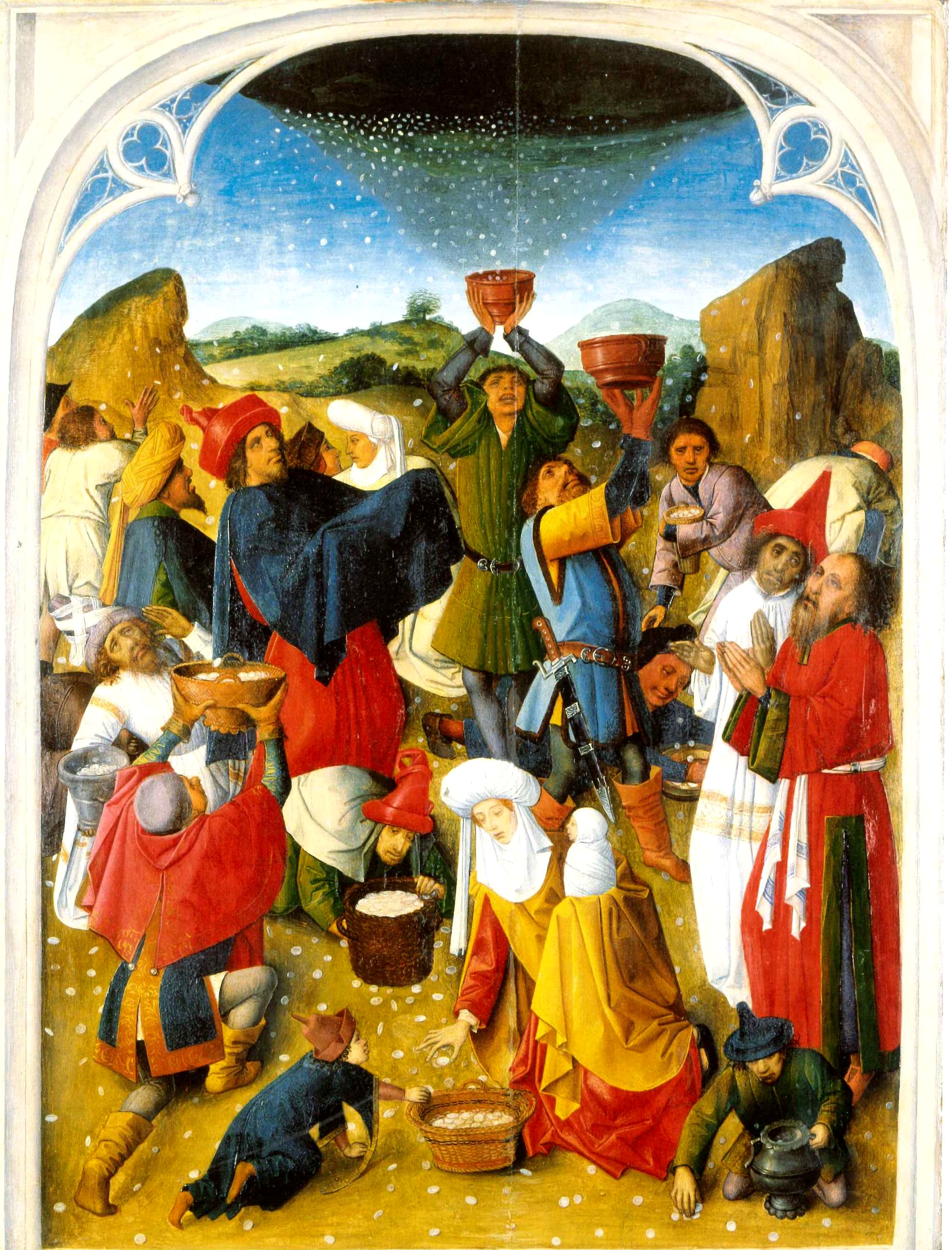 |
| The Gathering of Manna (c. 1465) |
He’s talking about the manna that the Israelites ate in the desert, and the water that they drank from the Rock. But notice: this spiritual food and drink was also physical food and drink. By this point, a picture should begin to emerge:
- Christ’s Resurrection spiritual Body isn’t a ghostly Body, but a physical Body that could be touched (and with which He could eat);
- Our spiritual bodies are glorified versions of our own physical bodies;
- The spiritual food and drink the Israelites ate and drank were physical food and drink.
- Jesus heals a man’s blindness by spitting into the dirt, and rubbing the resultant mud in the man’s eyes (John 9:6), then having him wash in the Pool of Siloam (John 9:7);
- Jesus heals a deaf-mute man by putting His fingers in his ears, then spitting and touching the man’s tongue (Mark 7:33)
- Jesus spits directly on a man’s eyes, and then lays hands on him twice, to cure him of blindness (Mark 8:23-25)
- A woman is healed by simply touching the hem of Jesus’ garment (Lk. 8:40-48).
- Jesus Christ died on the Cross for us, “being put to death in the flesh but made alive in the spirit” (1 Peter 3:18).
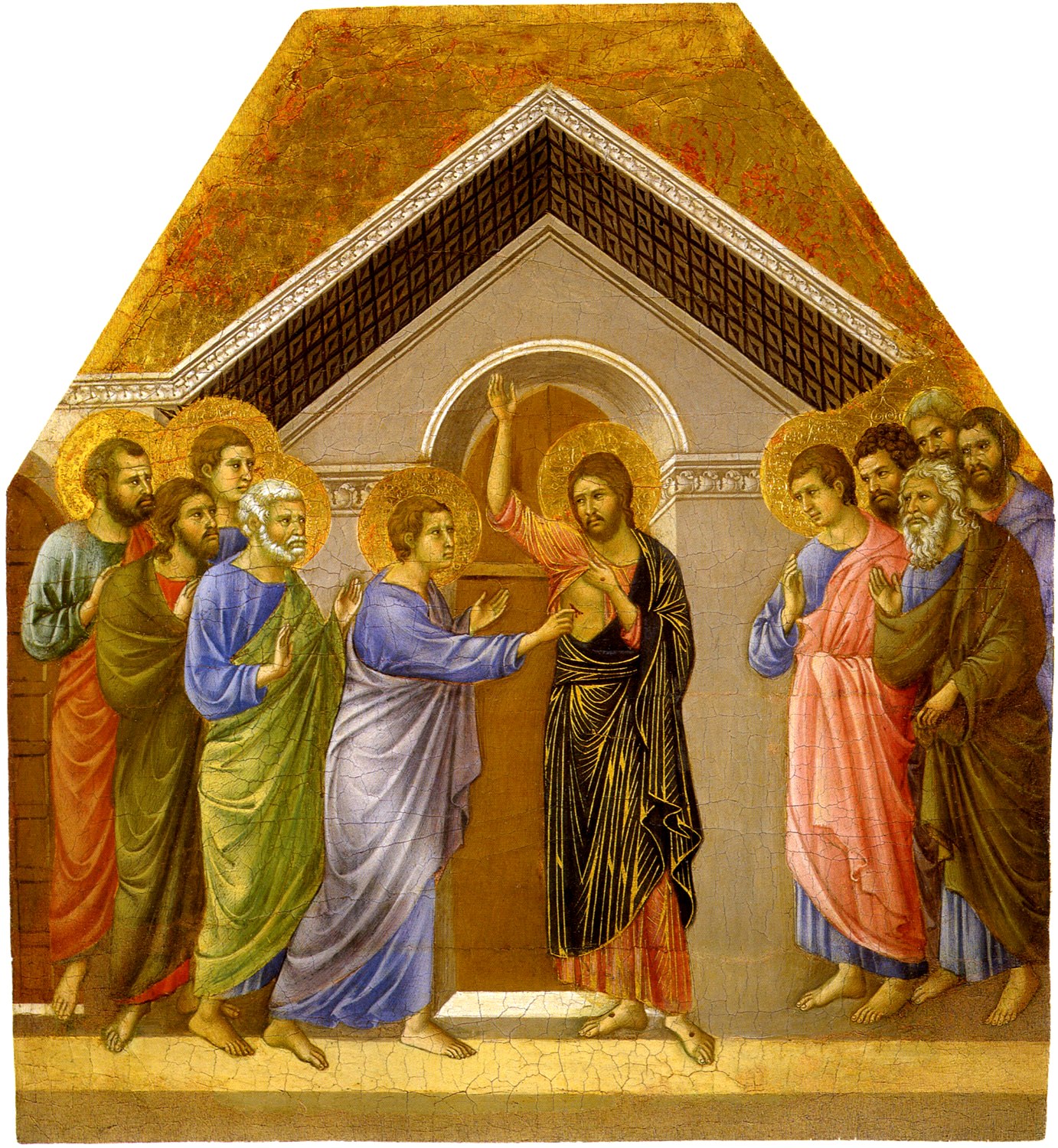 |
| Duccio, The Incredulity of Saint Thomas (1461) |
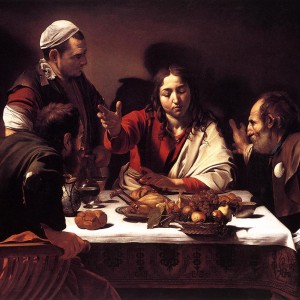

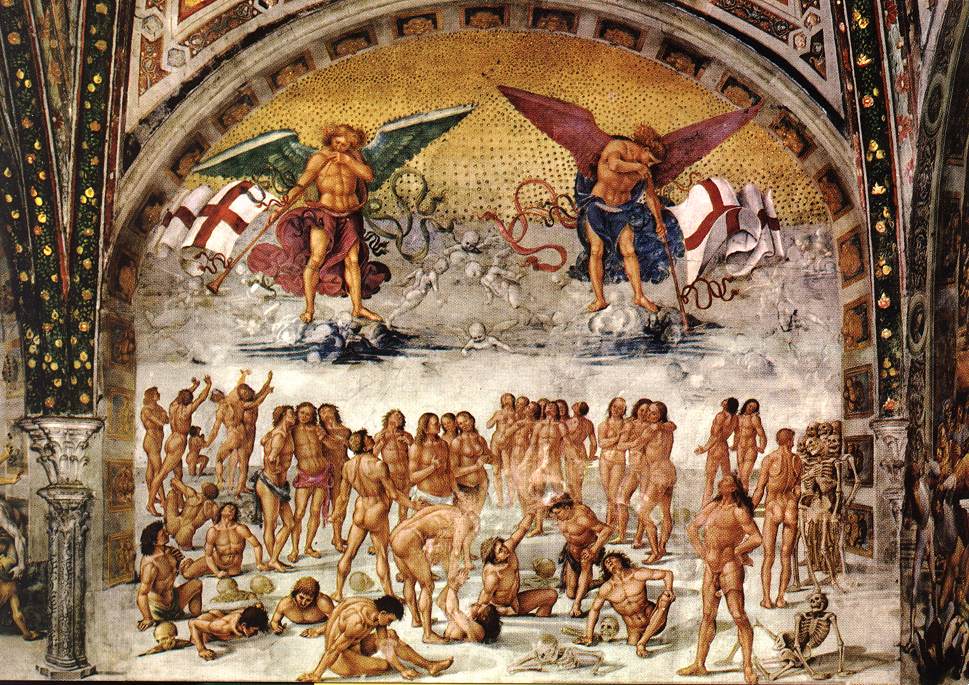
Thank you for this post. It clarified some things for me, and also led me to look up your post “What Scripture Says About Using Relics”. I’ve been dubious about relics, and even though I’m not going to be venerating anyone’s bones anytime soon, it certainly helped clarify the issue and set up a precedent for God working in that way. Thanks for the clarity!
God bless,
♥ee
Elizabeth,
That’s great! I understand that, despite the Biblical and Patristic basis for relics, there’s still a natural enough aversion, as it can seem a bit macabre. Perhaps something to take up in prayer.
For anyone interested, the post she’s referring to is this one: “What Scripture Says About Using Relics.”
I.X.,
Joe
I was going to post a quotation from “The Martyrdom of Polycarp” but then realized I already had on Joe’s original article! Turns out I’m rather predictable…*sigh*.
I was averse to relics for a long time. It has only been in recent years that this has changed. While explaining Gnosticism at Bible Study I realised that my Christianity was really rather Docetic. Somewhere along the line I had picked up the idea of “Spirit good, body bad”. I later came to the conclusion that I really didn’t have a very good appreciation for the significance of the Incarnation. When my perspective shifted, so many other things fell into place:
Christianity is not a spirituality divorced from physically, but one that is deeply rooted in the created order. Think for a moment about the “sensuous” nature of the Catholic Sacraments. They all engage our senses and, although they are concerned with the spiritual, they are concretely expressed through material things…
When we are Baptized, our bodies are washed with water. When we are Confirmed or suffering illness, we are anointed with oil. When we go to Confession, we confess our sins to a priest with our lips. When a man receives Holy Orders, it is through the imposition of the Bishop’s hands. When a man and women get married, they exchange rings and come together physically in the intimate marital embrace. Finally, at every Liturgy the faithful eat the Body and Blood of Christ under the appearance of bread and wine.
– Christmas Thoughts